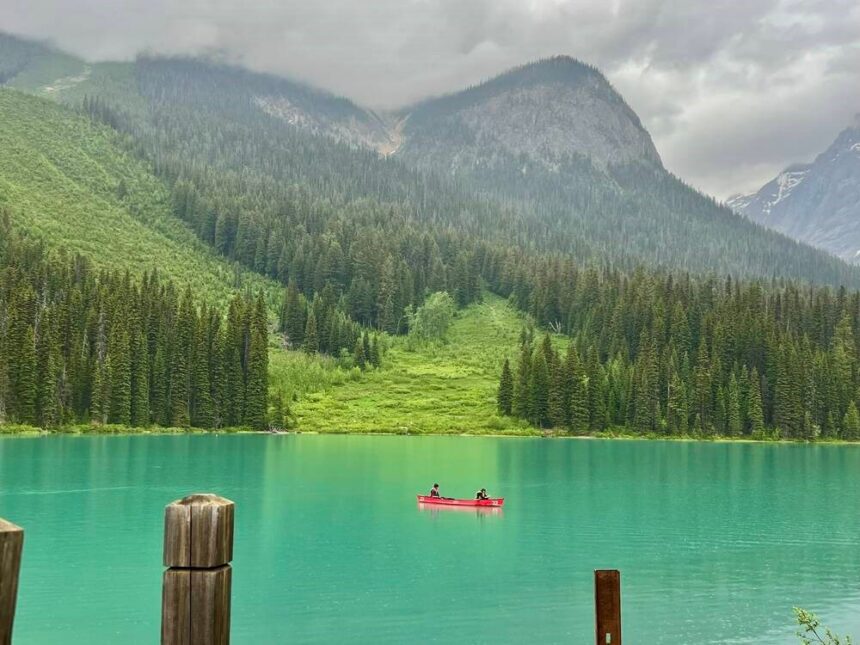The morning fog hangs like a silk curtain across the Kicking Horse River as I watch the first light touch the peaks of the Purcell Mountains. It’s 6:30 a.m. in Golden, British Columbia, and already I can hear the distant rumble of the Canadian Pacific Railway—a sound that has defined this landscape since the late 1800s when Swiss guides first arrived to help chart these formidable ranges.
“We don’t just live in the mountains—we live with them,” says Elena Haig-Anderson, whose great-grandfather was among the original Swiss guides who settled in the area. We’re sharing coffee at the Whitetooth Mountain Bistro, where the windows frame views that could easily be mistaken for the Alps. “My family has been here for four generations, but when visitors come through, they still ask if we’re from Switzerland.”
This confusion is understandable. Golden sits nestled between six mountain ranges in the Columbia Valley, bearing an uncanny resemblance to certain Swiss cantons. The European influence is unmistakable—from the timber-framed buildings that dot the revitalized downtown to the fondue nights that have become a staple at local restaurants.
I’ve come to Golden to explore what Tourism BC has quietly marketed as “Little Switzerland,” a destination that offers authentic alpine experiences without the transatlantic flight. What I discover is a town deeply connected to its mountaineering heritage while forging its own distinct Canadian identity.
At the Golden Museum and Archives, curator Ryan Bavin shows me black-and-white photographs of the Swiss guides who arrived between 1899 and 1954. These men, recruited by the Canadian Pacific Railway, were tasked with leading wealthy tourists through the Rockies during the railway’s expansion years.
“The CPR was brilliant,” Bavin explains. “They needed these mountains to be accessible to wealthy tourists, but they also needed them to be seen as exotic and challenging enough to be worth the journey.” The solution: import professional mountain guides from Switzerland who could safely lead visitors through Canada’s answer to the Alps.
The Swiss influence extended beyond guiding. Many of the guides married locally and stayed, bringing architectural styles, cuisine, and cultural traditions that transformed Golden from a railway stop into a mountain community with European sensibilities.
This history is physically embodied in the iconic timber-frame pedestrian bridge spanning the Kicking Horse River. Built in 2001 with the help of a Timber Framers Guild from across North America, the 150-foot covered bridge was designed by German timber frame expert Jürgen Rüdinger. It connects the historic downtown with newer developments and serves as a community gathering space that honors Golden’s European building traditions.
“We could have built a simple metal bridge,” says Joanne Sweeting, Executive Director of Tourism Golden. “But that wouldn’t have reflected who we are. This bridge tells our story—the blending of European craftsmanship with Canadian materials and community spirit.”
That spirit is particularly evident at Kicking Horse Mountain Resort, where I meet up with longtime local ski instructor Éric Rochon. As we ride the gondola 7,700 feet up to Eagle’s Eye Restaurant—Canada’s highest dining establishment—Rochon points out the distinctive terrain that makes Golden unique among North American ski destinations.
“What we have here is very European,” he explains as we ascend above the tree line. “Steep bowls, natural fall lines, and chutes that would be at home in the Alps. But we also have that Canadian thing—space. Even on busy days, you can find fresh lines and solitude.”
The resort’s development in the early 2000s marked a turning point for Golden, bringing international attention to a town that had previously been overshadowed by Banff and Lake Louise. Today, the resort offers 3,400 acres of skiable terrain and has helped establish Golden as a destination rather than a pass-through.
According to data from Destination BC, tourism in the Kootenay Rockies region, which includes Golden, has grown by approximately 23% since 2015, with particular growth in international visitors seeking authentic mountain experiences.
But Golden’s alpine culture extends beyond skiing. The town sits at the confluence of the Columbia and Kicking Horse rivers, making it a premier whitewater destination. It’s surrounded by five national parks, offering exceptional hiking, mountain biking, and wildlife viewing opportunities. The nearby Wetlands Wildlife Sanctuary provides habitat for more than 15 species of waterfowl and 95 bird species overall.
For those seeking a quintessential Swiss-Canadian experience, Alpine Helicopters offers heli-hiking trips to remote alpine meadows that bloom spectacularly from July through September. These meadows, filled with glacier lilies, Indian paintbrush, and mountain heather, create carpets of color against the backdrop of snow-capped peaks.
“When we take people up there, they often get emotional,” says pilot Sarah Jenkins. “There’s something about standing in those meadows that connects you to both the fragility and the permanence of these mountains.”
This duality—the delicate balance of preservation and access—is something Golden has navigated carefully. Unlike some mountain towns that have surrendered completely to tourism, Golden maintains a working-class soul anchored by forestry, the railway, and small businesses.
At the Wolf’s Den, a restaurant housed in a 1911 heritage building, I meet James McKnight, a third-generation logger whose family has witnessed Golden’s evolution. Over locally sourced elk burgers, he reflects on the town’s transformation.
“Twenty years ago, we wouldn’t have had places like this,” he gestures around the rustic-chic dining room. “But the changes have been mostly good. Tourism has brought opportunity without completely changing who we are.”
This sentiment is echoed throughout town, where European refinement coexists with Canadian practicality. At the Bacchus Books & Café, I browse an impressive selection of mountaineering literature while sipping expertly prepared espresso. Across the street, Mountain Goodness Natural Foods offers organic produce alongside gear for backcountry adventures.
As the sun sets behind the Purcells on my final evening, I join a small gathering at the Whitetooth Brewing Company. Named after the local ski hill that preceded Kicking Horse Resort, the brewery produces Belgian and West Coast-inspired ales that have garnered national recognition.
“We’re not trying to recreate Switzerland,” says co-founder Kent Donaldson. “We’re celebrating what Golden has become—a place where European traditions meet Canadian innovation, all surrounded by mountains that humble you daily.”
It’s this humility in the face of natural grandeur that perhaps best defines Golden’s particular charm. Like its Swiss predecessors who recognized both the beauty and danger of these peaks, Golden embraces its alpine setting with reverence and practicality.
As I raise a glass of the brewery’s award-winning Blower Pow IPA with new friends, I realize that Golden offers something increasingly rare in mountain tourism—authenticity. It’s a place where Swiss heritage is neither a marketing gimmick nor a historical footnote, but rather a living tradition that continues to evolve in distinctly Canadian ways.
The next morning, as my train pulls away from the station, I catch a final glimpse of the timber bridge spanning the river, standing as both a connection to the past and a path forward—much like Golden itself.






